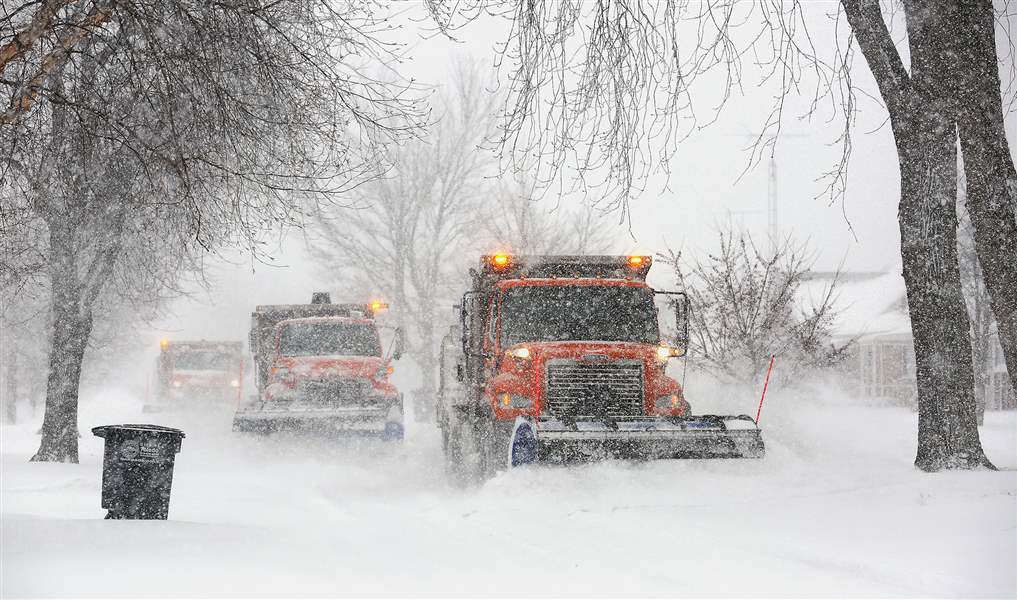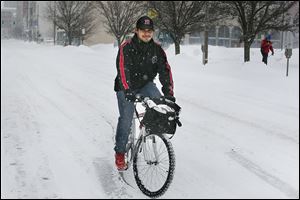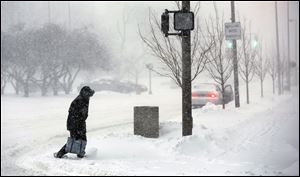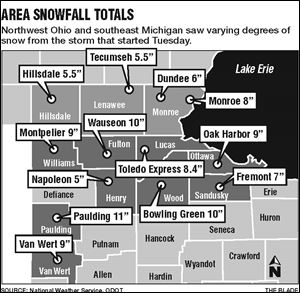
Snow causes leaders to flip-flop on Level 3
Many motorists unhappy with changing directives
2/6/2014
Snow plows work to clear 290th Street near Lehman Avenue as snow hammers the area on Wednesday.
THE BLADE/ANDY MORRISON
Buy This Image

Snow plows work to clear 290th Street near Lehman Avenue as snow hammers the area on Wednesday.

Hugo Ramirez of Jimmy John’s downtown, doesn’t let the snow — or the flip-flopping alerts — keep him from doing his job. He’d already arrived at work by the time the Level 3 was reinstated.
Don McClain drove from Napoleon to downtown Toledo on Wednesday morning to make boiler repairs at the historic Valentine Theatre.
When he left his home, Lucas County was under a Level 2 snow emergency, under which authorities recommend against travel but do not forbid it. But not long after he and a co-worker reached the Valentine, Lucas County Sheriff John Tharp had kicked the alert back up to Level 3, which meant all nonessential travel was prohibited.
“If they would have declared a Level 3 sooner, I wouldn’t have come in,” said Mr. McClain, describing snow-covered roads for his entire drive to Toledo and a stranded tow truck among the snowbound vehicles he witnessed.
“The day care called and my wife had to go get the boy; now I have to go get them,” he said.
PHOTO GALLERY: The return of #Snoledo.
By the time the snowfall ended early Wednesday afternoon, an official 8.4 inches were documented at Toledo Express Airport.
Higher snowfalls were reported across the region.
Bill Colter, Valentine Theatre building manager, said he measured 10 inches in the theater’s plaza, matching reports from Bowling Green and the Ohio Department of Transportation’s Fulton County garage in Wauseon.
ODOT reported 7 inches in Northwood and 9 inches in Oak Harbor and Montpelier, but just 4 inches in Tiffin.

A pedestrian crosses Jackson Street at North Huron Street on Wednesday during the height of the snowfall. Officially, 8.4 inches of snow fell, but near the Valentine Theatre, 10 inches were measured.
In Michigan, National Weather Service spotters reported 6 inches in Dundee, 8 inches in Monroe, and 5½ inches in Tecumseh and Hillsdale.
Sheriff Tharp, under consultation with Toledo Mayor D. Michael Collins and Carol Contrada, president of the Lucas County Commissioners, had declared a Level 3 alert effective at 11:30 p.m. Tuesday, several hours after light snow began falling at Toledo Express. But he relaxed that alert to Level 2 effective at 5:30 a.m., only to reinstate the travel ban at 9 a.m.
Lucas County’s alert level dropped back to Level 2 at 3:30 p.m., with other nearby counties that had banned nonessential travel during the storm also recoiling about that time.
Mr. McClain wasn’t the only person frustrated by the county’s flip-flopping alerts. Angry messages piled up on Sheriff Tharp’s Facebook page, from which they were deleted, and that of The Blade.
“This is crazy. This is nuts,” said Dick Lynch of Temperance, a courier who checked before driving into work under the Level 2.
“The driving conditions are the worst I’ve seen,” Mr. Lynch said. “It’s terrible, but my main problem was going up and down with the level ... because you’ve already enticed people to go to work, and now they have to go home in a Level 3.”
For many, the alert level did go back down before their workdays ended, prompting allegations it was manipulated for the benefit of Toledo employers — something the sheriff denied.
“What I was concerned about is the whiteouts in Jerusalem Township, the roads [are] not passable,” the sheriff said. “I was really concerned about somebody getting killed out there.”
The earlier decision to go to Level 2, the sheriff said, was based on relatively light snowfalls during the early morning hours, which was the time many forecasters had said would be the storm’s worst.
Instead, the heaviest snow fell at Toledo Express between 6 and 9 a.m., just after the level had been lowered. Hourly reports from the airport showed precipitation rates nearly triple what had occurred earlier in the morning, reaching about an inch per hour of snow.
“I feel horrible that people then had to go turn their lives around,” Sheriff Tharp said of the 9 a.m. Level 3 declaration. “But I just didn’t expect to be dumped on during the day. ... It changed on us. The weather changed.”
Jay Berschback, chief meteorologist at WTVG-TV, Channel 13, said a heavy snow band developed during the morning over the Toledo area and rotated as it advanced. The area closest to its rotational pivot point, he said, got the heaviest snow from that band — mainly from western Lucas County to about I-75.

That helped the area’s snowfall approach that of towns farther south where the storm arrived earlier Tuesday afternoon. “It was a real tricky storm,” he said.
“This storm was supposed to happen last night, but it didn’t. It happened this morning,” said David Welch, Toledo’s commissioner of streets, bridges, and harbor.
City plow crews focused on major arteries during and immediately after the storm — often running three or four trucks in tandem to remove snow.
Efforts also focused on downtown Toledo because of a concert Wednesday night at the Huntington Center, Mr. Welch said.
By evening, he said, streets crews had begun work on secondary “Phase 2” streets, while contractors and plows from other city divisions were on some of the residential routes.
Effective 7 a.m. today, the city will impose a snow parking emergency under which all parking is forbidden on major streets, generally defined as routes used by Toledo Area Regional Transit Authority buses. Cars parked on those streets are subject to ticketing and impoundment.
Cars on residential streets could be towed to other streets nearby so plows can get through, the city said. Those tows will be done at no charge to vehicle owners.
Parking bans remained in effect in other northwest Ohio cities, including Bowling Green, Tiffin, and Findlay.
Lucas County workers were among those who came in to work Wednesday morning before the alert was changed. “We didn't have any time to notify them not to come to work because of the time that the Level 3 was issued,” said Laura Lloyd-Jenkins, county administrator.
Totals since 1955 have been measured by the National Weather Service at Toledo Express Airport; official records were kept downtown before then. Total for the 2013-14 is season-to-date through Wednesday:
1. 1977-1978 — 73.1 in.
2. 1981-1982 — 68.2 in.
3. 1895-1896 — 63.7 in.
4. 2013-2014 — 62.8 in.
5. 1966-1967 — 60.6 in.
6. 1969-1970 — 59.4 in.
7. 2007-2008 — 58.1 in.
8. 1993-1994 — 56.8 in.
9. 2004-2005 — 56.0 in.
10. 1976-1977 — 53.9 in.
Source: National Weather Service — Cleveland
Instead, the county at 10 a.m. asked all employees to stay in their offices while road crews worked, with the “goal of establishing a safe environment for employees to return to home."
At the Monroe County Road Commission, Managing Director Randy Pierce said Wednesday night I-75 and U.S. 23 were in good shape, major surface roads were “two-track,” and he hoped to make headway on the paved secondary roads overnight. “In all honesty, we haven’t had the winds” that paralyzed the county with snowdrifts during the areas’s last major snow a month ago.
But the winter’s overall severity leaves the road commission and many other highway-maintenance agencies perilously low on rock salt. Mr. Pierce said his agency was cutting rock salt with 33 percent sand to stretch the remaining 4,000 to 5,000 tons in its stockpile.
“I’m having a hard time trying to find salt, but it’s the same problem everyone’s having,” he said.
The Ohio Department of Transportation said it had arranged to deliver 200,000 tons to seven locations statewide for distribution to county and municipal road agencies to help those running out.
Mr. Welch said before the latest storm that Toledo was in good shape for salt “as long as February isn’t like January,” when a record 40.2 inches of snow fell.
The 8.4 inches from this storm brought Toledo’s official season total to 62.8 inches, making this the fourth-snowiest winter on record with most of February and all of March to go. With average snowfalls for the rest of the season, the 73.1-inch record from 1977-78 is in play.
Skies are likely to be dry today and Friday, Mr. Berschback said, but it will be cold during the days and frigid overnight, with area temperatures likely to fall well below zero by Friday morning.
A “Clipper-type” storm is expected to pass through the lower Great Lakes during the weekend, possibly adding a few inches of snow to Toledo’s total, Mr. Berschback said.
Staff writers Taylor Dungjen and Mark Reiter contributed to this report.
Contact David Patch at: dpatch@theblade.com or 419-724-6094.